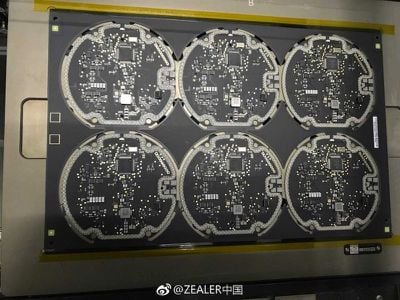Images claiming to offer a glimpse of the wireless charging pad circuitry to be paired with Apple's upcoming "iPhone 8" have been shared on Chinese microblogging platform Weibo today by technology website ZEALER (via iClarified).

The two photos show several assembled inductive charging kits in a plastic tray and a black PCB board of bare circuitry modeled on the assembled kits. As with most alleged leaks that appear on Weibo, it's extremely difficult to tell whether the images are authentic, but we're covering them here for completion.

KGI Securities analyst Ming-Chi Kuo has claimed the iPhone 8 and its companion devices, the "iPhone 7s" and the "iPhone 7s Plus" will all adopt glass bodies with metal frames to facilitate WPC-standard wireless charging functionality. The WPC-standard refers to the Wireless Power Consortium, which supports the Qi wireless charging functionality built into many Android devices.
According to Kuo, wireless charging will be enabled through an optional accessory sold alongside the new iPhones, rather than be included in the box. Separately, Apple blogger John Gruber has suggested that the accessory might not be available in September when the iPhones are expected to launch, but might ship later in the year instead alongside an iOS 11.1 software update.
I’ve heard that inductive charging will (a) be sold separately, and (b) might be late, waiting for iOS 11.1 (a la Portrait mode last year). https://t.co/N65dHMNQIJ — John Gruber (@gruber) July 8, 2017
Fast Company also reported that software issues, not components, would be the reason behind a possible delay in enabling wireless charging in the phones. According to their sources, if the software isn't ready, wireless charging could be unavailable when the phone first begins shipping.
Early rumors about the OLED "iPhone 8" and the iterative "S" cycle upgrades to the iPhone 7 and 7 Plus suggested Apple was considering a long-range charging feature, but that technology is yet to mature and there are likely challenges to overcome before it's ready for inclusion in a device like the iPhone. As such, Qi wireless charging is in line with rumors that have predicted the iPhone 8 will support inductive charging rather than a true wireless charging feature.
























Top Rated Comments
Until we see the addition of long range wireless charging, then my interest will be more Piqued.
Over time, it becomes clear that they're held to the same laws of physics that everyone else is. Language gets parsed a little more carefully. Claims get quietly walked back. The demonstrated performance is either in line with what skeptics predicted when first released, or it's done in controlled environments where they can operate under R&D licenses.
When the circus finally calms down, it becomes clear why they needed so much publicity up front: their whole strategy rests on changing the laws. They need to convince FCC to change the regulatory regime, and they're hoping the publicity will convince the agency that it's in the public interest to do so.
In the end, there's no new technology-- it's simply a lobbying effort.
It's an antenna array system. They claim 100's of elements in their far field version which is an engineering feat, but not new physics. They're applying beam steering and MIMO techniques from communications, but they want it treated under ISM regulations for industrial power equipment. The reason they want to be allowed to output the power of a microwave oven is because they think they can target it on a small bubble in your pocket.
What this means for us is entirely new levels of ambient radio power in our environment to get milliwatts into our phones. They've said as much.
I'm with @69Mustang -- if I'm missing something here, tell me what. I really do love a deep dive into science and tech. In the mean time, I've got no problem answering baseless claims that this wundertek is on the horizon with my informed skepticism.
You can shout , But , if you don' t understand something , it is smarter to ask questions.
None of this makes sense. That's like saying if they were planning to use OLED with the same use case as Android phones they would have already done it. Same with 1080p, 4K Apple TV, larger phones, etc. Apple dismisses stuff until they use it. It's marketing, not some brand new use case.
This makes no sense either. Qi charging was not necessary for water/sweat resistance. Apple could have easily charged the AW with a lightning port or contact pins. There are plenty of devices that charge through ports and with pins and have IP certification for dust and water intrusion. Qi was not necessary. Besides, no one would be charging a wet AW just like no one would be charging a wet iPhone.